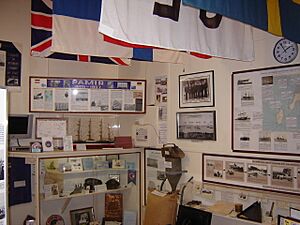Port Victoria Maritime Museum facts for kids

Port Victoria Maritime Museum and Jetty
|
|
| Lua error in Module:Location_map at line 420: attempt to index field 'wikibase' (a nil value). | |
| Location | Port Victoria, South Australia, Australia |
|---|---|
| Type | maritime history |
| Accreditation | registered with History SA |
The Port Victoria Maritime Museum is a cool place to learn about ships and the sea! It's a maritime museum found on the west coast of the Yorke Peninsula in Port Victoria, South Australia. The museum is inside an old cargo shed. This shed was built in 1878 from parts shipped all the way from the United Kingdom. Long ago, this shed stored household items for families settling in the area. These goods arrived by steamships from Port Adelaide before people's homes were ready.
Contents
Port Victoria's Shipping History
Port Victoria became a very busy port for shipping grain. The first big sailing ship to arrive was the Cardigan Castle. It loaded 1800 tons of grain in bags and sailed to Europe in February 1879. By 1883, 23 large sailing ships, called windjammers, had visited the bay.
The Grain Trade
The town of Port Victoria depended on the grain trade. Farmers grew the grain, and workers called lumpers loaded the heavy bags. From November each year, the town was full of activity. Harvested grain was brought into town and stacked high.
When the big sailing ships arrived, the bags of grain were taken down the jetty. Smaller boats, like ketches and schooners, then carried the grain to the huge ships anchored in the bay. The museum has old photos, displays, and videos that show what these times were like.
Finnish Ships and Cape Horners
Many sailing ships that came to Port Victoria in the late 1920s were from Finland. The largest group of these ships belonged to Gustaf Erikson. His home port was Mariehamn in Finland. Because so many of his ships visited Port Victoria, the town became known as the "Mariehamn of the South" to them.
In 1934, there were only 26 commercial sailing ships left in the world. An amazing 17 of them visited Port Victoria that year! The museum shares stories about these ships and the lives of their crews.
Journeys Around Cape Horn
Sailors on these ships often traveled eastwards through the very stormy "Roaring Forties" and "Furious Fifties" oceans. They went around Cape Horn, which is the southern tip of South America. These journeys could take anywhere from 83 days to over five months! It depended on the ship, the weather, and the skill of the captain and crew.
Sailors who successfully rounded Cape Horn were known as Cape Horners. Groups for Cape Horners were set up in many countries. The museum has special displays that honor these brave sailors, especially the Australian Cape Horners. The era of these large sailing ships ended in 1949. That's when the ships Pamir and Passat made the last commercial voyages without engines.
Museum Highlights
The Port Victoria Maritime Museum is famous for its displays of items found from shipwrecks. Many of these shipwrecks happened around Wardang Island. There's even a special trail called the Wardang Island Maritime Heritage Trail that visits the sites of eight shipwrecks.
The museum also has a "First Encounters Display." This section teaches visitors about the local Narungga Indigenous people and their culture. It also covers how Matthew Flinders and Nicholas Baudin mapped the Spencer Gulf. You can also learn about the large sheep farms that were set up on the Yorke Peninsula in the 1800s.


